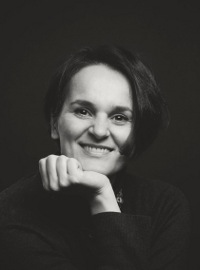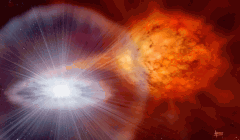Marialuisa Aliotta

Professor M Aliotta
- Position
- Professor of Experimental Nuclear Astrophysics
- Category
- Academic staff
- Location
-
James Clerk Maxwell Building (JCMB)
Room 8204
- Email: m.aliotta [at] ed.ac.uk
- Tel: +44 (0)131 650 5256
- Personal home page
- Edinburgh Research Explorer profile
Marialuisa is a member of the following School research institute, research groups and research area:
Research institute
Research groups
Research area
Research interests
My research interests focus Experimental Nuclear Astrophysics, specifically on the laboratory investigation of nuclear reactions that occur in stars and govern their lifetimes and evolution. I am interested in exploring the processes that account for the synthesis of the chemical elements both in quiescent stars like our sun and in explosive scenarios like novae, supernovae and X-ray bursts.
Quiescent stellar evolution involves reactions mainly between stable nuclei at energies well below the Coulomb barrier of the interacting species. Their experimental investigation in a terrestrial laboratory is severely hampered by the background induced by the cosmic rays in the detection devices. Thus, a unique approach consists in carrying out measurements underground, where the background induced by cosmic rays is suppressed by orders of magnitude. At present, the Laboratory for Underground Nuclear Astrophysics (LUNA) located under the Gran Sasso massif in Italy remains the only operational underground nuclear astrophysics laboratory worldwide. The LUNA collaboration, of which I am a member since 2010, has pioneered reaction cross-section measurements at ultra-low energies over the last two decades.
I am a member of the LUNA Collaboration Board and the PI of the Edinburgh team within LUNA. Other key collaborations focus on the direct study of low energy carbon fusion reactions at CIRCE (Caserta, Italy) and on the indirect investigations of key nuclear reactions with the Trojan Horse Method (Catania, Italy).
In contrast to quiescent stages of stellar evolution, explosive scenarios in astrophysics are triggered by nuclear reactions mostly between unstable nuclei, which do not normally exist on earth. Thus, experiments can only be performed at Radioactive Ion Beam facilities where such nuclei can be produced and accelerated at the required energies. Beam time at these facilities is obtained through an international competitive process. My interests in this area lay in the study of key nuclear reactions in X-ray bursts. I was the spokesperson for a time-reversal study of a key breakout reaction at TRIUMF (Canada), where I have led an international collaboration between Edinburgh, York and TRIUMF. For similar studies, I have submitted successful proposals and Letters of Intent at major international facilities, such as TRIUMF, GANIL, and CERN. Many of the proposed experiments await the development of the required radioactive beams with sufficient intensities for the proposed studies.
I am also a member of the ISOL-SRS collaboration, which aims to study nuclear reactions of astrophysical relevance using a storage ring at HIE-ISOLDE, CERN.
I am a member of the STFC Project Peer Review Panel (until 2011) and serve on the Sifting Panel for the STFC Rutherford Fellowships (since 2011). I waas a member of STFC Nuclear Physics Advisory Panel and of the UN Nuclear Physics Grants Panel. I regularly act as a referee for major physics journals and was a reviewer for large grant applications to international funding bodies (MIUR, NSERC, Helmoltzt Gesellschaft, SBF). I was co-Director of the UK Nuclear Physics Summer School (2011) and have been a member of the Scientific Committee for the European Summer School on Experimental Nuclear Astrophysics since 2010. In 2015, I co-chaired the VII International Conference Nuclear Physics in Astrophysics. Since Januray 2020 I chair the Experiment Evaluation Committee of TRIUMF (Canada) after haaving been a member since 2017.
I love teaching and I am passionate about it. Over the years, I have contributed both to the undergraduate and graduate teaching programme of the School, and to its administration. A list of the courses I have been teaching is given below.
Undergraduate Teaching
- Nuclear Physics (Lecturer, Workshop Leader and Course Organiser)
- Subatomic Physics (Lecturer)
- Physics 1A (Lecturer and Workshop Leader)
- Data Analysis (Tutor)
- Problem Solving in Physics (Tutor)
- Physics 1B Laboratory (Demonstrator)
- Practical Physics Laboratory (Laboratory Class Leader and Demonstrator)
Postgraduate Teaching
Delivered within SUPA
- Hands on Writing: How to Master Academic Writing in the Sciences (Course Creator and Workshop Facilitator)
- Advanced Topics in Nuclear Astrophysics (Lecturer)
I am a keen and supportive supervisor. My enthusiasm for teaching and communicating is reflected in the many invitations I receive to speak at international summer schools, conferences and public events.
I was an elected member of the School's Teaching Committee (2007-2011), a member of the SUPA Graduate School Management Committee (2006-2010), and of the School's Graduate Studies Committee (2005-2012).
Over the years I have taken up roled of increased responsibility also in the administrative runnign of the School. Amongst my main roles, I chaired the Forward Look Task Force (2010) and have devised and proposed a new framework for our degree programmes that allows for a greated flexibility and improved students experience. The new framework is currently being rolled out. In my capacity as the School's International Exchange Officer (2009-2011) I have established two new ERASMUS exchange agreements, with the Albert-Ludwigs Universitaet Freiburg and with the Technische Universitaet Muenchen (Germany).
Marialuisa currently offers the following PhD project opportunities:
Marialuisa has featured in the following recent School news stories:
- Funding success supports research in nuclear astrophysics and galaxy evolution
- Congratulations to the new Royal Society of Edinburgh Fellows
- Award recognition for Prof Marialuisa Aliotta
- Testing the early universe from deep underground
- Origin of meteoritic stardust unveiled by a revised proton-capture rate of oxygen-17

Stars in the lab
In this video Marialuisa explains that laboratory studies of thermonuclear reactions are crucial to understand the lives and evolution of stars, the synthesis of chemical elements, and ultimately our place in the Universe.Recent publications
- , Physical Review C, 112, 5, p. 1-7
- , Journal of Physics G: Nuclear and Particle Physics, 52, 10, p. 1-23
- , Reviews of Modern Physics, 97, 3, p. 1-74
- Towards a comprehensive study of the 14N(p,γ) 15O astrophysical key reaction: Description of the experimental technique including novel target preparation DOI, The European Physical Journal A (EPJ A), 61, p. 1-11
- , The European Physical Journal A (EPJ A), 61, p. 1-8

